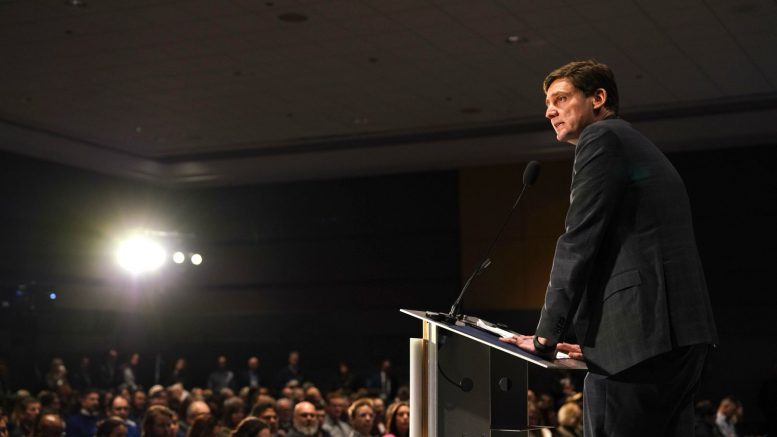British Columbia launched its Critical Mineral Strategy at Vancouver’s AME BC Roundup on Monday, proposing 11 actions to boost the mineral sector and attract investment, though some question the plan’s substance.
“The world needs a stable, free, democratic, high-standard producer of the metals and minerals needed to battle climate change,” Premier David Eby declared as he announced the strategy’s first-phase rollout. He underlined B.C.’s “generational opportunity to seize, to build wealth and protect the planet simultaneously,” to rousing applause.
The launch of the plan, which was only broadly outlined Monday, comes after Quebec, Ontario, Saskatchewan and Manitoba have already laid out their own strategies.
The strategy comprises nearly a dozen first-phase action points, including developing a B.C. critical minerals atlas; engaging and aligning with First Nations on strategy and infrastructure; and opening a dedicated project advancement office to offer streamlined support services — including a concierge, project management, and First Nations negotiators.
The strategy further aims to tackle obstacles impeding project development and workforce stability. Additionally, for critical mineral geoscience initiatives, $3.9 million is allocated over four years, starting in 2022-23. A new critical minerals advisory committee will provide guidance.
Fiscal policy missing
However, the Mining Association of British Columbia’s (MABC), president and CEO Michael Goehring, suggests the premier may have his priorities backwards. The association, which represents B.C.’s steelmaking coal, metal and mineral producers, smelters and advanced development companies, is concerned that the strategy lacks a crucial component: a competitive fiscal policy.
In particular, he cited the government’s new output-based carbon pricing system, which was announced last fall and will come into effect in April, as a barrier to mining.
“The B.C. government’s shift to an ‘output-based carbon pricing system (OBPS) spells trouble,” Goehring told The Northern Miner in an interview.
He said that while the mining and smelting sector in B.C. favours carbon pricing, it faces the highest carbon tax rates in Canada (up to three times that of Ontario or Quebec) and globally despite having the lowest greenhouse gas emissions. Compounding matters, the industry can’t reduce emissions further at present because technologies for zero-emission haul trucks are not expected to be market-ready until the end of the decade.
“It is essential that the carbon tax rates for existing and future critical mineral mines in B.C. are competitive with those in other provinces. Otherwise, the OBPS could negatively affect investment decisions in B.C., counteracting the objectives of the province’s critical minerals strategy,” he said.
AME BC president and CEO, Keerit Jutla, agrees that while the first-phase strategy announcement was a “step in the right direction,” he would also like to see more language on things that matter. “We understand this as a preliminary phase-one strategy. We anticipate a more substantive announcement with complete details to be released soon,” he told The Northern Miner.
Government has tasked the B.C. Ministry of Energy, Mines, and Low Carbon Innovation (EMLI) with filling out the details of the strategy, giving it a $6-million budget and three year timeline.
“We appreciate the government’s acknowledgement that more action is required to facilitate the development of new critical mineral projects. It is imperative that greater emphasis is placed on competitiveness and the fiscal and regulatory policies that will attract investment,” he said.
Jutla stated that while awaiting further developments, the members of AME BC will collaborate with the newly formed Critical Minerals Project Advancement Office. They will advocate for more assistance with permitting and regulatory procedures and seek advice on cooperating effectively with First Nations.
Infrastructure investment
In a Jan. 8 release, the MABC argued up to $36 billion of investment (which compounded over several decades could amount to $800 billion) is at risk in the province because the development of 16 proposed critical mineral mines hinges on the provincial government establishing more competitive fiscal and regulatory policies.
Premier Eby says under EMLI Minister Josie Osborne the ministry has achieved a 52% reduction in the backlog of permit applications.
Eby’s announcement follows on the heels of a Jan. 16 announcement of a $36-billion provincial investment in the next decade for expanding the province’s electricity infrastructure, critical for mining industry expansion.
Momentum is building elsewhere for the local critical minerals sector. In late 2023, B.C. announced a $1.1 billion partnership between E-One Moli and the governments of B.C. and Canada to bring lithium-ion battery cell production to Maple Ridge, part of Metro Vancouver, and create 450 permanent jobs.
In the 2022 budget, Ottawa allocated about $3.8 billion to its critical minerals strategy.
Exploration spending
Premier Eby announced the official government 2023 figures for exploration spending in the province, revealing a strong performance. Total mining production in 2023 was $15.9 billion, and exploration spending amounted to $643.5 million.
He said that exploration has amounted to $2.5 billion over the last five years, with mining production totalling $54.6 billion. B.C.’s mining sector employs over 35,000 workers, contributes $7.3 billion to gross domestic product in 2023, and is a significant exporter.


Be the first to comment on "BC’s first critical minerals strategy has some asking, ‘Is it enough?’"